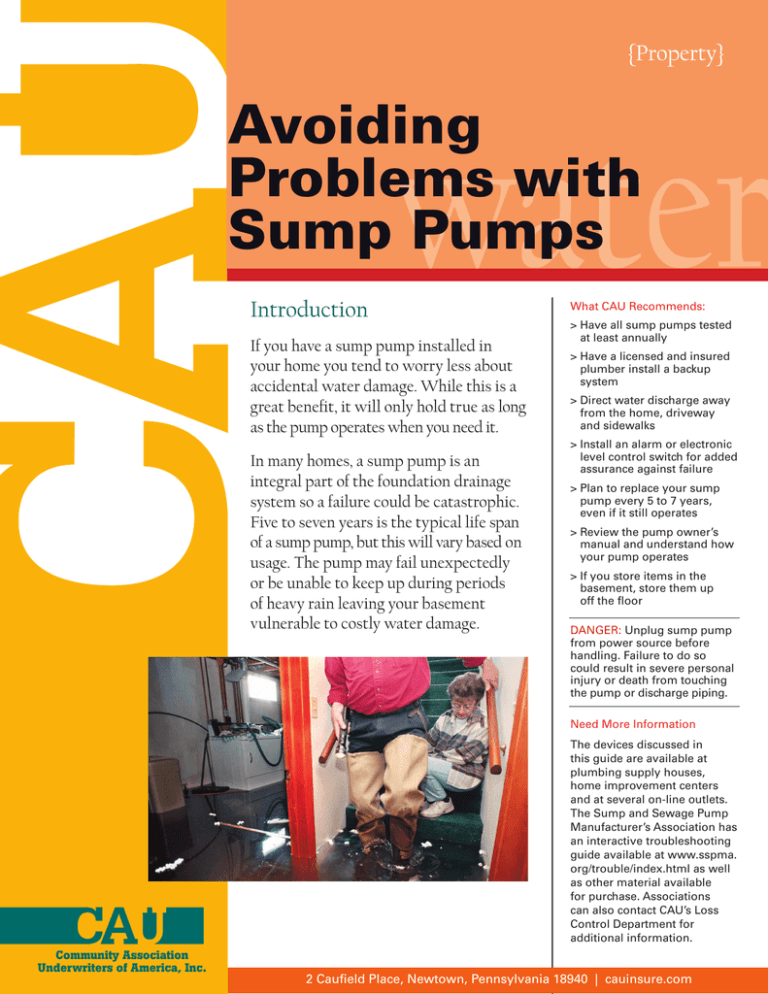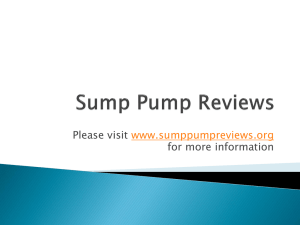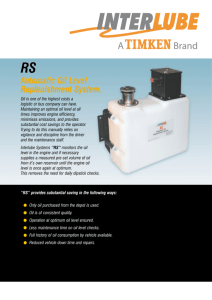
{Property}
Avoiding
Problems with
Sump Pumps
Introduction
water
If you have a sump pump installed in
your home you tend to worry less about
accidental water damage. While this is a
great benefit, it will only hold true as long
as the pump operates when you need it.
In many homes, a sump pump is an
integral part of the foundation drainage
system so a failure could be catastrophic.
Five to seven years is the typical life span
of a sump pump, but this will vary based on
usage. The pump may fail unexpectedly
or be unable to keep up during periods
of heavy rain leaving your basement
vulnerable to costly water damage.
What CAU Recommends:
> Have all sump pumps tested
at least annually
> Have a licensed and insured
plumber install a backup
system
> Direct water discharge away
from the home, driveway
and sidewalks
> Install an alarm or electronic
level control switch for added
assurance against failure
> Plan to replace your sump
pump every 5 to 7 years,
even if it still operates
> Review the pump owner’s
manual and understand how
your pump operates
> If you store items in the
basement, store them up
off the floor
DANGER: Unplug sump pump
from power source before
handling. Failure to do so
could result in severe personal
injury or death from touching
the pump or discharge piping.
Need More Information
The devices discussed in
this guide are available at
plumbing supply houses,
home improvement centers
and at several on-line outlets.
The Sump and Sewage Pump
Manufacturer’s Association has
an interactive troubleshooting
guide available at www.sspma.
org/trouble/index.html as well
as other material available
for purchase. Associations
can also contact CAU’s Loss
Control Department for
additional information.
Community Association
Underwriters of America, Inc.
2 Caufield Place, Newtown, Pennsylvania 18940 | cauinsure.com
{Property}
Types of Sump Pumps
There are two common types of electric sump pumps
that are used for primary water drainage – pedestal
and submersible.
Pedestal pumps stand upright in the sump pit with
the motor, meant to stay dry, located a few feet above
the sump pit. For basements that require frequent
water drainage, these pumps are ideal. Pedestal sump
pumps tend to be less expensive than submersible
pumps, but are noisier.
Submersible pumps work under water and are
installed right in the sump pit. These pumps tend to
be more expensive than pedestal pumps but are also
much quieter. They also have a longer life expectancy
because the sealed motor keeps moisture and dirt out.
Both styles of sump pumps operate by a float switch
that turns the pump on once the water reaches a
certain level in the sump pit. Sump pumps come
with a wide range of flow rates so it is important
that the pump’s rated flow capacity match the
expected water drainage requirements. Regardless
of which pump style you choose, equip the water
discharge pipe with a check valve to prevent water
from flowing back into the sump pit and causing the
pump to turn on and off more than necessary.
Backup Systems
If your home is subject to a high water table or is
located in an area where frequent flooding or storms
cause power outages, investing in a backup system
is a wise choice. A back up system can include a
back up pump or a secondary means of powering the
primary pump during a power failure.
The most common back up system involves installing
a second pump, at a higher level, in the sump pit.
There are two types of systems available. The first
is a rechargeable battery operated pump plugged
into the GFCI electrical outlet. The second system
uses the home’s domestic water pressure to operate
a backup pump if power is lost. Both of these pumps
can also operate as a secondary pump if the primary
pump is unable to keep up with the volume of water.
Another alternative for providing a back up to your
sump pump is an emergency generator. If your
home has a generator, contract with a licensed and
insured electrician to determine if the generator has
a sufficient maximum and rated output to support the
electrical load of the sump pump and to connect the
sump pump to the emergency generator.
In addition to back up systems, there are a variety of
electronic level control switches and pump alarms
available for most pump installations. These devices
will provide an added assurance against water
damage caused by pump failure.
Periodic Maintenance and Testing
Sump pumps do not usually require a lot of
maintenance. However, conducting periodic
maintenance and testing is the best way to ensure
that the sump pump will operate when required.
Common inspection, maintenance and testing
procedures recommended for sump pumps usually
include removing debris from the sump pit, operating
the pump and verifying that water is discharging
outside the home. The owner’s manual provided by
the manufacturer will list the specific maintenance
and testing procedures required for your pump. If
you are not comfortable completing these tasks you
should contract with a licensed and insured plumber
to complete them. You should also contract with a
plumber if you have a sealed sump pit that is part of a
radon remediation system.
Once the maintenance and testing is complete,
make sure to plug in all of the pumps that you have
unplugged. If a pump does not operate or other
problems arise, contact a licensed plumber to make
the necessary repairs.
Conclusion
A failed sump pump can lead to a catastrophic loss.
Compounding this is the fact that water damage
resulting from a failed sump pump is typically not
a covered loss in many insurance policies. Regular
maintenance and testing of you sump pump will help
to ensure that the pump operates when it is needed most.
If you need to install or replace a sump pump, be sure
to check with your local building code official for any
specific installation requirements or permits. Local
building codes will require a ground fault circuit
interruption (GFCI) outlet on a dedicated circuit as
the primary power source for a sump pump. These
same codes will also prohibit directing the pump
discharge into the municipal sewer system.
© 2011 by Community Association Underwriters of America, Inc., All Rights Reserved
Community Association Underwriters of America, Inc. does business as “CAU Services” in California, “CAU” in Nevada, “Community Association Underwriters Agency” in New York and
“Community Association Underwriters Insurance” in Utah.
IMPORTANT NOTICE - The information presented by CAU in this Risk Management Guide is based on information from sources which we believe to be reliable, but is not guaranteed and
may not be a complete statement of all available data. Any suggested actions recommended by CAU are based solely upon an analysis of available industry data and our best judgment.
You are encouraged to have your legal counsel review all of your proposed plans and policies before implementing them.
2 Caufield Place, Newtown, Pennsylvania 18940 | cauinsure.com | CAU Risk Management Guide P-7(7/11)




